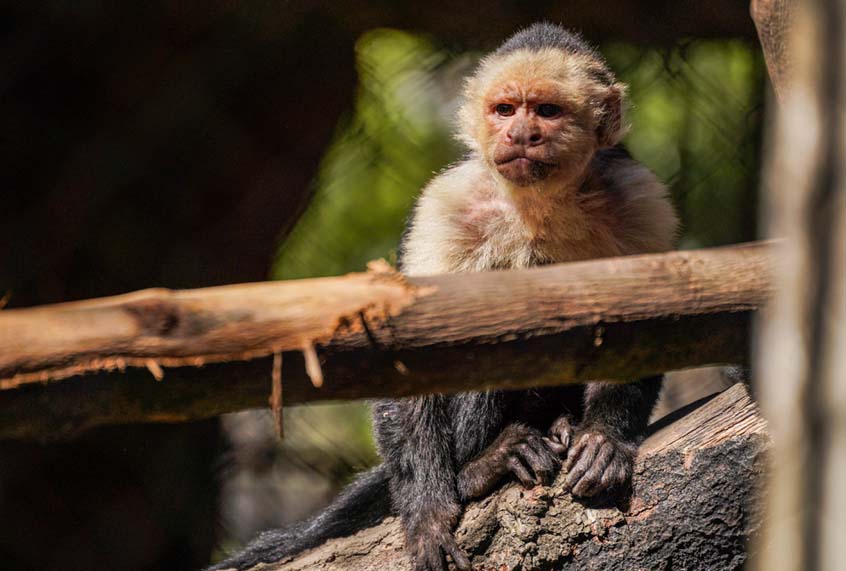If there ever were a science experiment that combined the power of artistic expression with the traditionally dry task of collecting data, it is the one conceived by Dr. Nicky Clayton and her PhD student, Elias Garcia Pellegrin. Perhaps unsurprisingly, Clayton is a dancer and Pellegrin has a background in performance theater. The scientists wanted to learn if monkeys could be fooled by sleight of hand magic tricks — specifically three species: common marmosets, Humboldt’s squirrel monkeys and yellow-breasted capuchin monkeys. The new study is published in the scientific journal Current Biology.
This trick required the scientists to put food in one hand, and present that hand to each individual monkey.
Clayton (a professor of Comparative Cognition at the University of Cambridge and a Fellow of the Royal Society) joined Pellegrin and other scientists in this Ig Nobel Prize–worthy experiment because they wanted to understand more about the nature of consciousness. They were not disappointed either: Of the three monkey species tested, only marmosets were not deceived. Intriguingly, marmosets are also the only tested monkeys that lack opposable thumbs. The scientists hypothesize that this detail is related to why the magic tricks did not work on them.
As Clayton, Pellegrin and co-authors Rachael Miller and Clive Wilkins explain in the study, sleight of hand magic requires observes to expect specific manual movements, and thus can be used to test the mind-body relationships in animals with hands similar to (but not exactly the same as) human beings. Hence, the authors chose the 24 monkeys for whom they would perform magic tricks, and selected a feat known as “the French drop effect.” This trick required the scientists to put food in one hand, and present that hand to each individual monkey. As the monkey reached out for the treat, the researcher’s other hand would reach over and appear to grab it. Since the palm of the second hand now faced inward, monkeys that possess opposable thumbs tended to assume the treat was being clutched in that second hand where they could no longer see it. When the second hand was opened to reveal that it was still empty, those monkeys then discovered to their surprise that the treat had never left the first hand.
Except for marmosets, of course: They do not have opposable thumbs, so their eyes never left the first hand.
Because monkeys are as unique as humans, the members of each species did not react synchronously. Even so, the patterns were unmistakable: Capuchin monkeys were fooled by the French drop 81% of the time and squirrel monkeys were fooled by the mealworms 93% of the time, while marmosets were only taken in 6% of the time.
In contrast, when the scientists used an adapted version of the trick (with a “power grip” that all three species can perform), all of the monkey species were fooled.
“It tells us something about how we think without work,” Clayton explained to Salon. “We know this because we know . . . there’s this massive power in this non-verbal communication. And then I think of seeing non-human animals respond in that way to these non-verbal stimuli. It creates all kinds of questions in your mind, doesn’t it? Why is it so soothing to us? What does it mean for the animals that watch it?”
Want more health and science stories in your inbox? Subscribe to Salon’s weekly newsletter The Vulgar Scientist.
“We used magic effects because most of the effects essentially are nonverbal.”
The scientists chose to use magic tricks because, of all the various art forms that could be utilized, magic entailed an ideal combination of interactivity and nonverbal communication.
“We used magic effects because most of the effects essentially are nonverbal,” Clayton said, noting that such tricks “reveal interesting things about blind spots in thinking.” She said that because the effects are non-verbal, you can use them on “non-verbal animals and pre-verbal children, and they might tell you something interesting about the thinking processes and the assumptions we make as human beings about the way in which your thinking processes work.”
In addition to demonstrating the complexity of primate brains, the new Current Biology paper also raises profound questions about how consciousness relates to our physical bodies. Clayton told Salon that one of the reasons she became involved in this project is because of her previous research on birds like crows and jays, noting that her “research led us to monkeys because we realized we needed to think about fingers and thumbs, more than just wings that might work like hands.” Clayton said the research suggests that “embodied knowledge” exists in animals, too.
“My background is, I’m both a dancer and a scientist,” Clayton told Salon. “My whole thing is embodied knowledge because that’s what dancers have to do. If you are taught complex choreographic sequences as a dancer, you have to embody them and put them within your own body in order to know how to move.” This sense of the body — and of others’ bodies — is what inspired Clayton, she says.
“Most people think your own interpretation of the world is how your brain thinks and remembers — which is totally correct — but obviously it’s also modulated by how your own body works, how your own experiences change the way you feel and shape the way you interpret that information.”
Read more
about consciousness

